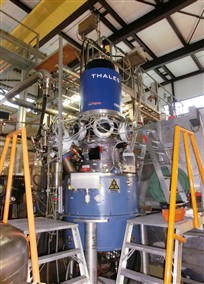Excellent results for the European gyrotron prototype

The 1 MW gyrotron prototype manufactured in Europe by French company TED on behalf of F4E
Excellent results have been obtained for the first high-power 1MW gyrotron prototype manufactured in Europe by French company Thales Electron Devices (TED) on behalf of F4E. Designed to transform electricity power into 1 MW electromagnetic waves equivalent to about 1000 microwave ovens during a continuous use of up to one hour, the gyrotrons will be sources of ITER’s Electron Cyclotron (EC) heating system which will heat the plasma in the ITER machine to the sweltering temperature of 150 million degrees C necessary for the fusion reaction to occur by transferring the energy from electromagnetic waves at 170 GHz of frequency into the plasma electrons.
During testing, the gyrotron repeatedly produced up to 0.8 MW of output power during periods of 180 seconds – the maximum time possible at the test facility at Karlsruhe Institute of Technology (KIT – as part of the European Gyrotron Consortium (EGYC)).These results have been assessed by an independent expert panel who concluded that for a first gyrotron prototype, they are impressive.
“With these tests a large majority of the F4E objectives for the validation of the EU gyrotron design, have been verified”, says Ferran Albajar, F4E Technical Officer responsible for the gyrotron. “The design of this gyrotron has been carefully optimized for the specific environment of ITER, and the assessment was based on the ITER’s stringent technical requirements in terms of power, quality and stability of the electromagnetic waves. The assessment also included aspects linked to quality control procedures and collecting and sharing know-how in order to allow European industry to reproduce future gyrotrons”.
In addition to the gyrotron, testing was carried out on the superconducting magnet necessary for the gyrotron to work. The magnet is special for three reasons: it is the first time such a magnet for a high-power gyrotron is built in Europe using a state of the art cryogen-free cooling technology; the strength of the magnetic field within the magnet corresponds to the high expectations the scientists have had (reaching 7.1 Tesla – equivalent to the magnetic force of 1420 fridge magnets); and the magnetic field lines are well-placed and form a virtual cylinder equivalent to the approximate diameter of a human hair in order to assist the gyrotron in generating the electromagnetic waves.
Next steps will now involve joining the gyrotron and magnet together and carrying out testing at the Swiss Plasma Centre (SPC). Each test session will last for one hour and thus simulate the time needed for these components to work in ITER.
